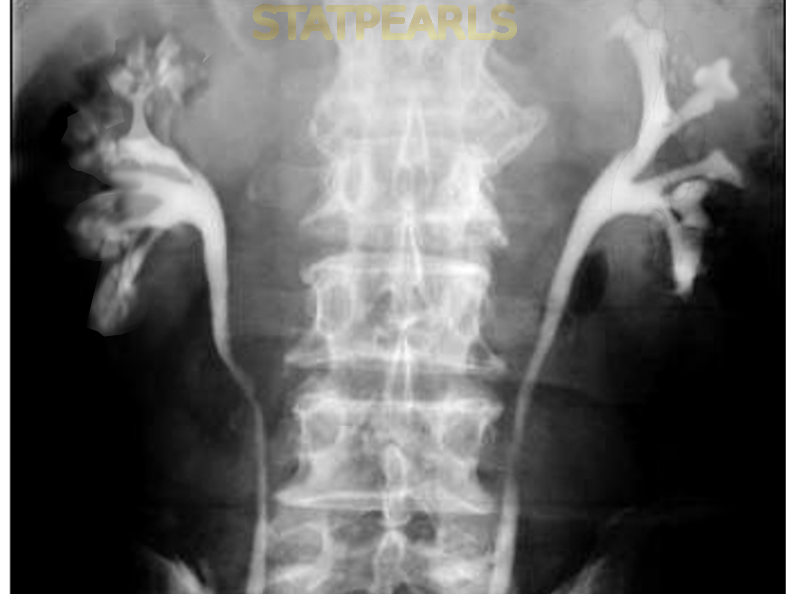[1]
Gambaro G,Feltrin GP,Lupo A,Bonfante L,D'Angelo A,Antonello A, Medullary sponge kidney (Lenarduzzi-Cacchi-Ricci disease): a Padua Medical School discovery in the 1930s. Kidney international. 2006 Feb;
[PubMed PMID: 16395272]
[2]
Xiang H,Han J,Ridley WE,Ridley LJ, Medullary sponge kidney. Journal of medical imaging and radiation oncology. 2018 Oct
[PubMed PMID: 30309197]
[3]
Vasudevan V,Samson P,Smith AD,Okeke Z, The genetic framework for development of nephrolithiasis. Asian journal of urology. 2017 Jan
[PubMed PMID: 29264202]
[4]
Janjua MU,Long XD,Mo ZH,Dong CS,Jin P, Association of medullary sponge kidney and hyperparathyroidism with RET G691S/S904S polymorphism: a case report. Journal of medical case reports. 2018 Jul 9
[PubMed PMID: 29983117]
Level 3 (low-level) evidence
[5]
Imam TH,Patail H,Patail H, Medullary Sponge Kidney: Current Perspectives. International journal of nephrology and renovascular disease. 2019;
[PubMed PMID: 31576161]
Level 3 (low-level) evidence
[6]
Fabris A,Anglani F,Lupo A,Gambaro G, Medullary sponge kidney: state of the art. Nephrology, dialysis, transplantation : official publication of the European Dialysis and Transplant Association - European Renal Association. 2013 May
[PubMed PMID: 23229933]
[7]
Chatterjee R,Ramos E,Hoffman M,VanWinkle J,Martin DR,Davis TK,Hoshi M,Hmiel SP,Beck A,Hruska K,Coplen D,Liapis H,Mitra R,Druley T,Austin P,Jain S, Traditional and targeted exome sequencing reveals common, rare and novel functional deleterious variants in RET-signaling complex in a cohort of living US patients with urinary tract malformations. Human genetics. 2012 Nov
[PubMed PMID: 22729463]
[8]
Gambaro G,Danza FM,Fabris A, Medullary sponge kidney. Current opinion in nephrology and hypertension. 2013 Jul
[PubMed PMID: 23680648]
Level 3 (low-level) evidence
[9]
Swonke ML,Mahmoud AM,Farran EJ,Dafashy TJ,Kerr PS,Kosarek CD,Sonstein J, Early Stone Manipulation in Urinary Tract Infection Associated with Obstructing Nephrolithiasis. Case reports in urology. 2018
[PubMed PMID: 30595937]
Level 3 (low-level) evidence
[10]
Geavlete P,Nita G,Alexandrescu E,Geavlete B, The impact of modern endourological techniques in the treatment of a century old disease--medullary sponge kidney with associated nephrolithiasis. Journal of medicine and life. 2013
[PubMed PMID: 24868267]
[11]
Marien TP,Miller NL, Characteristics of renal papillae in kidney stone formers. Minerva urologica e nefrologica = The Italian journal of urology and nephrology. 2016 Dec
[PubMed PMID: 27441596]
[12]
Katabathina VS,Kota G,Dasyam AK,Shanbhogue AK,Prasad SR, Adult renal cystic disease: a genetic, biological, and developmental primer. Radiographics : a review publication of the Radiological Society of North America, Inc. 2010 Oct
[PubMed PMID: 21071372]
[13]
A dental convention with a difference--opportunity or responsibility?, McIntosh WG,, Dental journal, 1977 Sep
[PubMed PMID: 25615853]
[14]
Marcelissen TA,Smits MA,Van Kerrebroeck P, [A woman with urinary tract infections and flank pain]. Nederlands tijdschrift voor geneeskunde. 2012
[PubMed PMID: 23031231]
[15]
Meyer A,Vetter W, [Recurrent flank pain, microhematuria]. Schweizerische Rundschau fur Medizin Praxis = Revue suisse de medecine Praxis. 1985 Nov 12
[PubMed PMID: 4081442]
[16]
Uchida T,Takechi H,Oshima N,Kumagai H, Medullary sponge kidney diagnosed by unenhanced magnetic resonance imaging. Iranian journal of kidney diseases. 2015 Jan
[PubMed PMID: 25599731]
[18]
Gaunay GS,Berkenblit RG,Tabib CH,Blitstein JR,Patel M,Hoenig DM, Efficacy of Multi-Detector Computed Tomography for the Diagnosis of Medullary Sponge Kidney. Current urology. 2018 Mar
[PubMed PMID: 29692693]
[19]
Koraishy FM,Ngo TT,Israel GM,Dahl NK, CT urography for the diagnosis of medullary sponge kidney. American journal of nephrology. 2014
[PubMed PMID: 24531190]
[20]
Sun H,Zhang Z,Yuan J,Liu Y,Lei M,Luo J,Wan SP,Zeng G, Safety and efficacy of minimally invasive percutaneous nephrolithotomy in the treatment of patients with medullary sponge kidney. Urolithiasis. 2016 Oct
[PubMed PMID: 26671346]
[21]
Bhojani N,Paonessa JE,Hameed TA,Worcester EM,Evan AP,Coe FL,Borofsky MS,Lingeman JE, Nephrocalcinosis in Calcium Stone Formers Who Do Not have Systemic Disease. The Journal of urology. 2015 Nov
[PubMed PMID: 25988516]
[23]
Carpentier X,Meria P,Bensalah K,Chabannes E,Estrade V,Denis E,Yonneau L,Mozer P,Hadjadj H,Hoznek A,Traxer O, [Update for the management of kidney stones in 2013. Lithiasis Committee of the French Association of Urology]. Progres en urologie : journal de l'Association francaise d'urologie et de la Societe francaise d'urologie. 2014 Apr
[PubMed PMID: 24674339]
[24]
D'Alessandro MM,Pavone G,Castiglione MC,Tranchida AM,Sapia MC,Cusumano R,Corrado C,Mongiovì R,Maringhini S, [Nephrocalcinosis in children]. Giornale italiano di nefrologia : organo ufficiale della Societa italiana di nefrologia. 2015 Dec
[PubMed PMID: 29710439]
[27]
Chesney RW,Kaufman R,Stapleton FB,Rivas ML, Association of medullary sponge kidney and medullary dysplasia in Beckwith-Wiedemann syndrome. The Journal of pediatrics. 1989 Nov
[PubMed PMID: 2809912]
[28]
Wikström B,Backman U,Danielson BG,Fellström B,Johansson G,Ljunghall S, Ambulatory diagnostic evaluation of 389 recurrent renal stone formers. A proposal for clinical classification and investigation. Klinische Wochenschrift. 1983 Jan 17
[PubMed PMID: 6843037]

